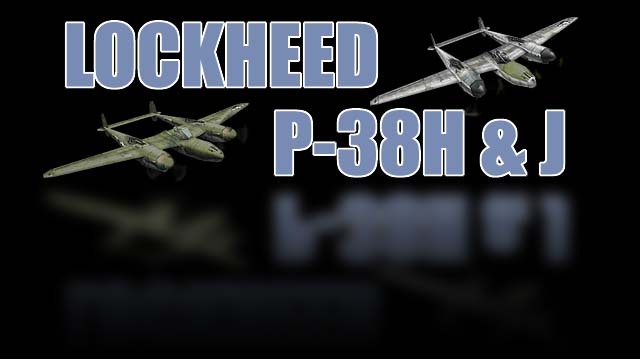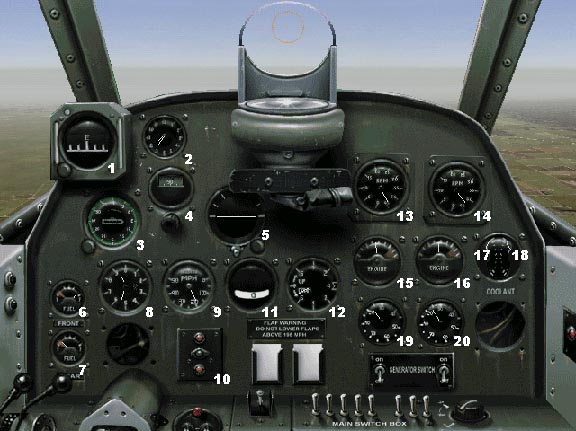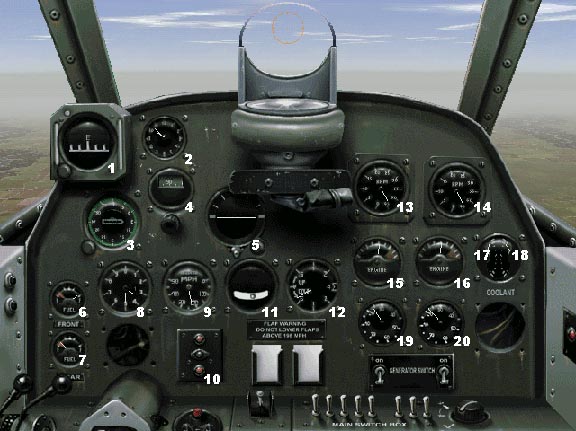
European Air War

Lockheed P-38H Lightning
The P-38 earned a reputation as a mediocre aircraft in the ETO, a label which has been attributed to several causes including cold weather operations, high-altitude icing, and even low-octane fuel. It excelled, however, in the PTO's warmer weather, where the P-38 generally operated at lower altitudes. The P-38 served as the Allies' primary long-ranged escort fighter until the introduction of the P-51.
The counter-rotating propellers negate engine torque, making for a very stable, easy-to-fly aircraft. Losing an engine, however, results in an amazing amount of torque and makes the aircraft extremely difficult to fly. Fortunately, pilots reported that the aircraft exhibited no substantial problems either turning toward or away from a dead engine. Further, the P-38 is, quite simply, too fast for its own good. In a dive, it can reach very high speed very quickly, resulting in an uncontrollable nose-down attitude. The P-38J features electrically-actuated "dive flaps" (which helps slow the aircraft) and hydraulically-boosted controls (which gives the pilot more control).
The P-38 is a decent dogfighter, and ETO pilots reported it could out maneuver any Luftwaffe fighter between 18,000 and 31,000 feet, and hold its own against lower-altitude opponents. Some pilot accounts mention dropping the maneuvering flaps to improve instantaneous turn performance, although other combat vets seemed to shun the idea since it increases drag. Although the pilot must be careful to control speed during a dive, the P-38 is generally fast enough to get itself out of trouble. It carries a respectable, nose-mounted armament. The centerline weapons configuration concentrates the firepower on a single point regardless of range, unlike fighters with wing-mounted guns (which converge at a range somewhere between 100 and 200 yards).
Lockheed P-38H Lightning (View Cockpit)

1. Magnetic Compass
2. Clock
3. Repeater Compass
4. Gyro Compass
5. Artificial Horizon
6. Fuel Gauge
7. Auxiliary Fuel Gauge
8. Altimeter
9. Airspeed Indicator
10. Landing Gear Position Indicator
11. Turn and Bank Indicator
12. Rate of Climb Indicator
13. Tachometer 1
14. Tachometer 2
15. Engine Temperature Gauge 1
16. Engine Temperature Gauge 2
17. Oil Pressure Gauge 1
18. Oil Pressure Gauge 2
19. Manifold Pressure Gauge 1
20. Manifold Pressure Gauge 2
Specs
- Wingspan: 52 ft. 0 in.
- Length: 37 ft. 10 in.
- Height: 12 ft. 10 in.
- Wing Area: 328 sq. ft.
- Engine: 2 x Allison V-1710-89/91 rated at 1,600 hp.
- Fuel: 300 gal. internal
- Loaded Weight: 16,300 lb.
- Wing Loading: 50 lb./sq. ft.
- Maximum Speed: 402 mph.
- Service Ceiling: 39,000 ft.
- Rate of Climb: 3,500 ft./min
- Combat Radius: 275 miles
- Armaments: 1 x 20mm Hispano cannon, 4 x .50 cal. Browning machine guns
- Ammunition: 150 rds (20mm), 500 rds/gun (.50cal)
Lockheed P-38J Lightning (View Cockpit)

1. Magnetic Compass
2. Clock
3. Repeater Compass
4. Gyro Compass
5. Artificial Horizon
6. Fuel Gauge
7. Auxiliary Fuel Gauge
8. Altimeter
9. Airspeed Indicator
10. Landing Gear Position Indicator
11. Turn and Bank Indicator
12. Rate of Climb Indicator
13. Tachometer 1
14. Tachometer 2
15. Engine Temperature Gauge 1
16. Engine Temperature Gauge 2
17. Oil Pressure Gauge 1
18. Oil Pressure Gauge 2
19. Manifold Pressure Gauge 1
20. Manifold Pressure Gauge 2
Specs
- Wingspan: 52 ft. 0 in.
- Length: 37 ft. 10 in.
- Height: 12 ft. 10 in.
- Wing Area: 328 sq. ft.
- Engine: 2 x Allison V-1710-89/91 rated at 1,600 hp.
- Fuel: 410 gal. internal
- Loaded Weight: 17,500 lb.
- Wing Loading: 53 lb./sq. ft.
- Maximum Speed: 414 mph.
- Service Ceiling: 44,000 ft.
- Rate of Climb: 3,800 ft./min
- Combat Radius: 350 miles
- Armaments: 1 x 20mm Hispano cannon, 4 x .50 cal. Browning machine guns
- Ammunition: 150 rds (20mm), 500 rds/gun (.50cal)
Notes: Both variants had limited dive speed due to a compressibility problem and also featured very slow initial roll rates. The P-38 Lightning should be flown clean for all mission types except Strike and Search & Destroy. For Strike missions, you have the choice between two 500 lb. bombs or two 1000 lb. bombs. Both configurations are effective against hard targets like railroads, bridges and other structures, so you must weigh the loss of mobility posed by the 1000 lb. ordnance package against the level of damage you are trying to inflict on the target. The 500 lb. ordnance package is the best choice in most cases because it provides a nice balance between the offensive and defensive capabilities of the aircraft.
This material was included in the original 1998 release of European Air War by Microprose.
